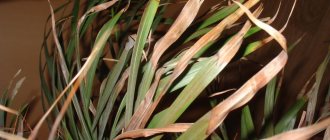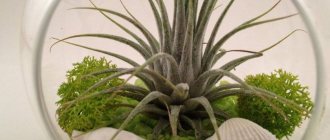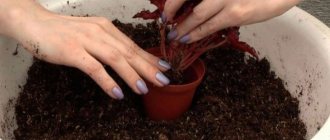In greenhouses and open ground, tomato bushes are often affected by diseases. Some of them carry pests, while others attack plants due to non-compliance with agricultural practices or the consequences of unfavorable weather.
Any of these reasons can have dire consequences for your crop. Therefore, it is so important to identify the disease in time and begin treatment. Of course, this is not so easy to do in the field, because many pathogens are perfectly camouflaged. But we hope that detailed descriptions and photographs will help you navigate.
Below we will look at the most common signs of fungal, viral, bacterial and some other diseases that can attack your beds. We will also present measures to combat them.
When using chemicals, remember that tomatoes can be eaten only 3-4 weeks after the last treatment.
Brown spots on leaves, stems and fruits of tomatoes
Brown necrosis with a light edge forms on the leaves and stems. A whitish coating is noticeable on the reverse side of the leaf blades in humid weather. The plant dries out. The inside of the fruits becomes covered with brown spots and rots.
Diagnosis: late blight of tomatoes is a fungal disease caused by microscopic fungi Phytophthora infestans.
The disease becomes more active in damp weather, and is especially dangerous in the second half of summer, when night temperatures become much lower than daytime readings. Fogs and dew also influence the development of the disease. At risk are tomatoes in open ground and film greenhouses without heating. After the leaves and stems are damaged, late blight spreads to the fruits and makes them unfit for consumption. If signs appear at the beginning of the growing season, complete loss of the crop is possible. The disease spreads very quickly, especially in humid weather.
Phytophthora also affects potatoes, eggplants, sweet peppers and other nightshades.
Control measures. To prevent the appearance of late blight, spray the plantings with Abiga-Peak, Consent, Revus or other fungicidal preparations. Repeat the treatment every 10 days. If the bushes are severely damaged, use the fungicides Kuproxat or Infinito. Just before ripening - biological products Fitosporin and Gamair. If the fruits begin to turn black, remove the remaining unripe tomatoes and place them in hot water (50°C) for a minute. Then dry and put in a box for ripening.
- Effective folk remedies for late blight on tomatoes and potatoes
The fight against late blight is not an easy task. How to protect tomatoes and potatoes from this disease?
Small spots on leaves, dark sunken spots on tomato fruits
Spots up to 1.5 cm in length are noticeable on the leaves and stems, sometimes with a black coating. Lesions most often form along the edges of the leaf. Then the spots increase in size and merge. The stems crack and the fruits become pitted with dark, dry spots.
Diagnosis: Alternaria blight, or dry spot, of tomatoes - a fungal disease.
Alternaria blight attacks plants immediately after planting tomato seedlings in open ground or a greenhouse. The fungus loves dry and hot weather, so it is especially dangerous for plants in glass greenhouses and film greenhouses. All parts of the bush are affected, and in the absence of treatment, yield losses amount to up to 85%. Fruits from infected bushes cannot be stored. The disease is easily transmitted to potatoes, and vice versa, so it is better not to plant them next to tomatoes.
Control measures. Spray the affected bushes with a 0.4-0.5% solution of Ordan. The fungicides Ridomil Gold, Poliram, Cumulus and Sectin Phenomenon have also proven themselves well in the fight against Alternaria blight. Carry out the treatment according to the instructions every 7-10 days until the signs of the disease disappear.
Round brown spots with dark edging on tomato leaves
Small watery spots appear on old and then young leaves. At first they are not very noticeable, but then they turn white and become covered with a brown edging. The rest of the leaf turns yellow and dries out. The fruits are small and flaccid. Young leaves at the top of the bush are rarely affected.
agroflora.ru
Diagnosis: septoria, or white spot, of tomatoes - a fungal disease.
Most often, the disease affects plants in open ground. Foci of septoria can also occur in a greenhouse with high humidity. The fungus spreads from the lower leaves and base of the stem higher and higher, damaging young leaves, shoots and flowers. As a result, the bush is forced to spend energy on restoring green mass, and not on setting fruits and their ripening. Fungal spores quickly spread throughout the garden bed. High humidity, heat, and windy weather contribute to the reproduction and dispersion of the pathogen.
Control measures. At the initial stage of infection, it is important to remove the affected leaves so that the spores are not scattered with the wind to other plants. If the bush is completely affected by septoria, it is better to dig up the plant and burn it. Fungicides Ridomil Gold, Ordan, etc. are suitable for treating tomatoes. Spraying with copper sulfate (50-100 g per 10 liters of water) is also effective.
Main bacterial diseases of tomato
More than 20 bacterial pathogens infect this crop worldwide. The intensity of their development and harmfulness depends on the soil and climatic conditions of the regions; a third of these bacterial pathogens are still absent in the Russian Federation. The most common and dangerous bacterial diseases in our country are bacterial canker, stem necrosis, bacterial black spot and bacterial spot (mottling).
Bacterial canker of tomato
Bacterial canker of tomato is widespread. This disease is typically vascular in nature. Signs of its manifestation are expressed mainly in the form of withering of plants: bacteria, penetrating the vascular system, cause withering of its shoots. This process begins from the lower tiers of leaves: they experience a loss of turgor (sometimes on one side of the leaf), while the fading parts of the leaf turn yellow along the edge and curl. In some cases, such a manifestation of bacteriosis may be its only external sign.
It can take 1.5-2 months from the beginning of wilting to the complete death of the plant. During primary infection, damage to the vascular ring (in the form of its darkening) is noted in the stems and at the base of the petioles of diseased leaves. Early damage to fruits by the causative agent of the disease leads to their deformity: the seeds darken and lose their viability. Infection of the ground organs of fruit-bearing plants manifests itself in the form of brown sores on young sepals, stems, petioles, especially on the stalks, which causes fruit to fall off. With later infection, the fruits may have an outwardly healthy appearance and normal pulp consistency.
Local manifestation of symptoms of bacteriosis on fruits occasionally occurs in the form of characteristic spotting, which is called “bird's eye”. At the first stage, small affected areas of green fruits look like white spots; at the next stage, when the fruits ripen and color, the center of the spots turns yellow. These birds' eye symptoms can develop on both wilt-affected and non-wilt-affected plants. Sick fruits are delayed in their development and are usually unevenly colored compared to healthy ones.
With severe development of the disease, light brown stripes, cracks and ulcers appear on the petioles and stems, from which yellow mucus protrudes. On a cross-section of such affected organs, the browning of the bundles of the vascular system is clearly visible.
The pathogen enters the plant through mechanically damaged tissue: through injured roots, stems, leaves. At high air humidity, the pathogen is able to infect the plant through open stomata.
Infection of tomato bacterial canker is spread by plant debris, seedlings, and soil, but the dominant role belongs to infected seeds, infected superficially or internally. The pathogen is also transmitted by pinching and pruning plant leaves. With permanent tomato cultivation, the soil serves as a reservoir for bacterial infection. The most favorable conditions for the development of bacteriosis are a temperature of 20...28 ° C and a relative air humidity of 80-85%. During the rainy season in hot weather, the spread of the disease can take the form of epiphytotics.
Black bacterial spot of tomato
Black bacterial spot of tomato is quite widespread and harmful, especially in greenhouses. The high harmfulness of the disease is noted in years with hot summers: then the damage to seedlings can be up to 50%, and to fruits - 20%. The harmfulness of bacteriosis manifests itself in damage to the above-ground parts of plants, as a result of which the plant does not produce a fruit crop, or the fruits are of low quality.
Bacteriosis affects the cotyledons, leaves, petioles, stems and fruits of tomato, and young tissues are more susceptible to the pathogen than aging ones. Seedlings and young plants suffer greatly from bacteriosis. At the first stage, very small depressed watery brown spots of irregular shape are noted on the leaf blades of young leaves, translucent in transmitted light and quickly increasing in size (up to 1-2 mm), then the center of the spots gradually turns black. Under favorable conditions for the development of the disease, the spots merge, the leaves curl and dry out. Black elongated spots form on the stems and petioles.
The same picture is observed on the stalks, shoots and pericarps. When the peduncle is severely damaged, massive flower shedding occurs. When fruits are affected in the early phase, dark convex dots, surrounded by a watery border, first appear on their surface, which over time take on the appearance of ulcers. Unlike the typical symptoms of bacterial bird's eye cancer, the dark, scab-like spots are not surrounded by a light border.
The development of black spot is influenced by meteorological conditions. The lower the temperature, the slower the development of black spot. Bacteriosis is transmitted by seeds and plant debris. The infection can persist on seeds for more than a year. Even with a latent infection, seeds can produce apparently healthy seedlings, which in the future can serve as a source of spread of bacteriosis. For this reason, it is important to purchase guaranteed healthy seeds. The pathogen persists for a very long time in parts of plants that are difficult to rot.
Bacterial spotting (mottling) of fruits
Bacterial spotting (mottling) of fruits is somewhat less common than others. Depending on weather conditions, crop losses from bacteriosis in the private sector vary widely (5-30%). The disease is most dangerous during early spring plantings - with high humidity and low night air temperatures.
The disease affects all above-ground organs of the plant (leaves, stems, petioles, flowers and fruits). Small black spots (irregularly rounded) with a yellow edge are usually noted on the leaves; sometimes they are located along the edges of the leaf; the center of such spots is raised, with a yellowish-green halo, then darkens. With the active development of a bacterial infection, these spots merge, causing the leaves to curl and die. Similar spots are noted on petioles, stems and flowers.
Damage to flowers that completely dry out and fall off is especially dangerous. Young green fruits are more susceptible to mottling. At the first stage of the disease, small, slightly convex black spots appear on their surface, surrounded by a whitish (as if watery) border, which then gradually grow (up to 6-8 mm), taking the form of ulcers. Over time, the watery border may disappear. The main source of bacteriosis infection is seeds, but the pathogen is able to survive in the soil and rhizosphere of plants.
Necrosis of the stem core (hollowness)
In recent years, a relatively new bacteriosis for our region, necrosis of the stem core (empty stem), characterized by high harmfulness, has become increasingly dangerous and rapidly spreading. The reduction in yield from premature death of plants can be up to 20-30%. The rapid manifestation of the disease is favored by differences in day and night temperatures, as condensation moisture forms on the plants, as well as the application of excess nitrogen fertilizers.
The initial signs of bacteriosis are observed during fruiting (formation of the second or third cluster): in the central part of the leaf lobes (between the veins) light, rounded-oblong spots appear, which gradually increase in size, and the leaf lobes curl upward (this is especially noticeable on sunny days) .
Manifestations of bacteriosis on leaves, which can be affected in any part of the plant, are very diverse: sometimes necrosis of the apex of the central lobe of leaves is recorded, which spreads like a “tongue” along the central vein. Affected leaves have a “scalded” appearance, although they remain green in color and have dark green oily veins visible. First, small oblong spots are observed on the surface of diseased stems, located mainly 25-30 cm above the soil level. Later, in most cases, necrotic stripes of a dark green color and a length of 25-50 cm develop on diseased stems, which is one of the main characteristics of this disease. In this case, severe maceration of the affected tissues is possible with destruction of the core, from which a mucous white or cream-colored exudate can be easily squeezed out on a cross-section; Bacterial mucilage is sometimes also released from stem scars left by leaves.
At a later stage of development of the disease, cracks with voids inside and with browned core tissue are often noted in the stems. In the main healthy stems (both in the basal part and along their entire length), a large number of aerial roots are formed, changing color from white to rusty brown, and in the places where they form, the inside of the stem is hollow: it seems that the plant is wasting the contents of the stems for their regrowth. The root system of such plants usually does not show signs of damage.
The process of plant withering develops gradually, and most often their final death is observed during fruiting. In mature fruits taken from diseased plants, double rings may be visible around the peduncle: dark brown in the center and light brown along the periphery. Sometimes short (4-6 mm) rays extend from this outer ring, in the area of which cracks then appear. In some cases, characteristic “networks” of light gray veins are noted on the fruits.
The development of the disease is facilitated by alternating high daytime (above 25°C) and low temperatures, which leads to the formation of droplet-liquid moisture on the surface of tomato leaves. If conditions for the development of the disease are unfavorable, weakly affected plants (with minor changes in the color of the stem core) may complete the growing season and produce a small harvest of fruit.
The source of primary infection of stem necrosis is seeds and plant debris. A major role in the spread of the pathogen is played by the contact method of transmission of infection during plant care.
Protective measures against tomato bacterioses
Protective measures against tomato bacterioses include a complex of various agrotechnical techniques, as well as the use of biological and chemical means of protection. These measures should be aimed at creating optimal cultivation conditions for plants, which enhances their protective reactions to diseases. On the other hand, the techniques used must simultaneously serve to reduce and suppress bacterial and fungal infections, limit the spread of diseases and create conditions favorable for the development and growth of plants.
Protective measures include:
- the use of varieties characterized by complex resistance to bacterial and fungal pathogens;
- pre-planting seed treatment;
- application of balanced fertilizer rates (excessive unilateral application of nitrogen fertilizers is avoided);
- spraying plants with preparations when the first signs of disease appear;
- careful regulation of temperature and air humidity in the greenhouse (to reduce air humidity, if necessary, the room is regularly ventilated;
- watering strictly between rows - at the root with a small stream (and also avoiding excessive soil moisture);
- regular removal of both heavily affected fruits and diseased plants entirely (along with twine);
- systematic control of weeds and insects (reservoirs of pathogens);
- taking precautions when collecting fruits to avoid mechanical damage;
- collecting and storing seeds from healthy plants;
- thorough cleaning of greenhouses and surrounding areas from debris and plant debris at the end of the season;
- compliance with crop rotation with the return of nightshades to their place no earlier than after 3-4 years;
- carrying out high-quality autumn digging (deeply buried plant residues rot during the winter period).
As a preventive measure, seeds are disinfected immediately before sowing by heat treatment in hot water (48...50°C) for 20 minutes. To warm up, the seeds are placed in a gauze bag and immersed in hot water. The water temperature is maintained within strictly specified limits, since at temperatures above 50°C the seeds lose their germination, and below 48°C this method has no effect. After warming up, the seeds are quickly cooled in cold boiled water (3-4 minutes), spread in a thin layer and dried in air (but not in the sun) until they flow.
Positive results against tomato bacteriosis are shown by spraying plants during the growing season with a 0.5% solution of Abiga-Pik, BC (no more than 3 times). Spraying cucumber plants with solutions of other copper-containing fungicide preparations - cuproxate, KS (25-50 g/10 l of water), cartocide, SP (40-60 g), copper oxychloride, SP (40 g), oxychoma, SP (20 g/10 l) – will have a positive effect on reducing the development of bacterial diseases during the growing season. Of the biological products, Fitolavin-300, Baktofit and Gamair show high efficiency. There is information about a significant inhibition of the development of bacterial pathogens by the liquid preparation Planriz, which is living bacterial cells; applied by 2-3 times processing of seedlings and plants.
SHV
Photos provided by the authors of the article
Yellowish spots on tomato leaves
First, the lower leaves become stained, then the disease spreads to the entire plant. The leaves dry out, curl and fall off, and hard olive-colored spots are visible on the fruits.
sazhaemvsadu.ru
Diagnosis: cladosporiosis, or brown spot, of tomatoes - a fungal disease.
The development of the disease is facilitated by growing in unheated and rarely ventilated greenhouses. Leaves are most often affected. Fruits, stems and ovaries are less likely to suffer. But since the plants lose their leaves, the harvest is very poor. And if the disease spreads to the fruits, they shrink and dry out.
Control measures. Treat the first lesions with Abiga-Pik or Polyram. During the summer, spray the bushes with a 0.05% solution of Fitosporin. For prevention, regularly remove old leaves and maintain the humidity in the greenhouse no higher than 80%.
Resistant varieties
The most reliable prevention of black bacterial spot in tomatoes is the selection of resistant varieties:
- A little prince;
- Lights of Moscow;
- Spartak F1;
- Virtuoso;
- Orange Giant;
- Pickling miracle;
- Profitable;
- Ray;
- Carrot;
- Bohemia F1;
- Blitz F1;
- Opera F1.
Buy certified seeds and only from trusted places with a good reputation. Maintain crop rotation and ensure that weeds do not grow in the tomato beds. All the tips described above will help you grow healthy tomatoes without black spots on the fruit.
White coating on tomato leaves
The leaves on both sides are covered with a white coating. Round spots are located throughout the leaf blade, then merge and darken.
mislife.ru
Diagnosis: tomato powdery mildew is a fungal disease.
The development of the disease is facilitated by excess nitrogen fertilizers and errors in irrigation. Powdery mildew does not cause much damage to open ground tomatoes, but greenhouse tomatoes have a hard time. Photosynthesis processes are disrupted and leaves gradually die. With severe damage, the stems and peduncles turn white. The fungus weakens plant immunity and significantly reduces yield. If measures are not taken, the bush may die entirely. Many summer residents mistake the white coating for dust, but in fact it is the mycelium of the fungus, which grows very quickly and is transferred to other plants. It can also coat fruits, impairing their taste.
Control measures. When the first signs appear, treat the tomatoes with fungicides Quadris, Topaz, Cumulus, Privent, etc. For prevention, spray the beds with a 0.5% Baktofit solution. After two weeks, repeat the procedure. Carry out the third treatment 7-10 after the second.
Dark sunken spots on tomato fruits
The fruits are covered with softened spots up to 1 cm in diameter. At first they are hardly noticeable and do not differ from the color of the skin. Then they darken and turn black. The fruits are completely mummified. Brown flaky spots are visible on the roots.
seminis.ru
Diagnosis: tomato anthracnose is a fungal disease.
Anthracnose is widely found both in open ground and in greenhouses. More often, mature bushes suffer from it. The peak of the disease occurs in late summer and early autumn. Mainly fruits, roots and root collars are affected. Ripe tomatoes cannot be eaten; they are watery and tasteless. The spots darken over time, and fungal spores become visible on them. Anthracnose often appears on bushes together with Alternaria, causing a mixed infection.
Control measures. Remove the affected fruits and spray the bushes with copper oxychloride (40 g per bucket of water) or 1% Bordeaux mixture. The latter can also be used to prevent disease. To do this, spray the plantings 3-4 times every 10-12 days. When the greenhouse is empty, completely disinfect it with bleach (200 g per 10 liters of water).
Symptoms
Adult developed plants are the first to suffer at the stage of ovary emergence:
- brown oblong spots appear on the stems, looking slightly depressed;
- Over time, they crack and whitish mucus flows out;
- aerial roots appear in the lower part of the bush;
- when you cut a plant, you can see the death of its internal part - first it becomes watery, then transparent and eventually turns black;
- the upper leaves darken and lose their elasticity, sometimes wither and fade;
- the fruits become covered with spider veins, the seed coat dies;
- when shaken, the ovaries fall off the bush.
Necrotic spots on leaves and stems, white spots on tomato fruits
The stalks and petioles become covered with ulcers, the stems crack, and mucus is released from them. The leaves dry out and curl on one side, but do not fall off. The fruits are speckled with small hard spots. The plant is withering.
Diagnosis: bacterial canker of tomatoes is a disease caused by non-spore-forming aerobic bacteria.
Cancer most often affects greenhouse tomatoes growing in conditions of high humidity and insufficient lighting. High temperature and waterlogged soil also influence the development of the disease. Crop losses can reach 30%.
Control measures. Affected plants cannot be treated. Dig them up and burn them. Treat the remaining tomatoes with 1% Bordeaux mixture to prevent infection.
Routes of infection and development conditions
The causative agent of bacterial spot of tomato can survive on plant debris, weeds and on the surface of seeds. Unlike bacterial spotting of tomato fruits, for which the infectious origin on the surface of the seeds is not significant, for bacterial spotting this is the most important source. In the soil, the pathogen dies immediately after decay of plant residues, and in seeds the infection can persist for up to 10 years. In addition, infection on the surface of seeds affects seedlings and very young plants.
The pathogen has practically no opportunity to penetrate through healthy leaf integument. Infection almost always penetrates in places of mechanical damage from insects, equipment, grains of sand flying with the wind, etc. The presence of liquid moisture, high air humidity and a temperature of 24 to 30 degrees are favorable for the development of infection.
Tomato leaves are curled, yellowish in color, and have a white coating on the roots.
The lower leaves quickly die and the petioles become deformed. The tops of the bushes become limp. The vessels in the stems turn brown, metabolism is disrupted and the plant withers.
koppertus.com
Diagnosis: fusarium wilt of tomatoes - a fungal disease.
The disease is very dangerous because The fungus that causes fusarium is resistant to many chemicals. This makes diagnosis difficult. Many people confuse the disease with non-infectious chlorosis, which occurs from improper watering and fertilizing, or verticillium, which is also characterized by wilting. Meanwhile, it is the pronounced chlorosis in this case that excludes the disease with verticillium and, together with the signs described above, indicates the infectious origin of the disease.
Control measures. Treat affected plants with Benazol or Strekar. These preparations can also be used to treat seeds before sowing. For prevention, after planting in the ground, water the tomatoes with Pseudobacterin.
The lower leaves of tomatoes dry out and fall off, the upper leaves curl
The leaves partially turn yellow, then necrotic spots appear on them, and the roots gradually die.
kccc.ru
Diagnosis: verticillium wilt, or verticillium wilt, of tomatoes - a fungal disease.
Until recently, verticillium was one of the most dangerous and widespread diseases of tomatoes. But today, many varieties and hybrids that are resistant to it have been bred, so infection occurs less and less often. Meanwhile, the fungus that causes wilting still lives in the soil and, under favorable conditions (low temperature and high humidity), infects plants. Young tomato bushes that have just begun to grow are especially affected.
Control measures. For treatment, use the drugs Previkur, Trichodermin. After picking, when the plants take root, feed them with the following mixture: 2 g of copper and zinc sulfate, 3 g of boric acid and 10 g of potassium permanganate per bucket of water. After 10 days, repeat the procedure. Carry out the third feeding after 20 days, and after another 30 days - the fourth. This will strengthen the immunity of tomatoes.
Fighting methods
Science does not yet know how to treat an infection when the disease has already manifested itself. There is no cure; you can only reduce the number of primary infections and protect the remaining bushes on the site using prevention methods.
Having discovered a diseased bush, it is immediately pulled out and burned.
Then the soil where it grew is watered with one of the solutions:
- "Fitolavin-300". 20 ml of the product are diluted in a ten-liter bucket of water and the contaminated soil is spilled at the rate of 5 liters per 1 square meter. m.
- Potassium permanganate. 10 g of crystals are diluted in a bucket of water. The soil is spilled to a depth of 15 cm.
Biological
It is recommended to soak suspicious seeds in Baktofit solution. For 1 kg of seeds you will need 5 g of product. It will help partially save the seed, but if the disease has already developed in the plantings, it is powerless.
For large planting volumes, strains of the Trichoderma fungus can be purchased. This tool is still in development and is not widely used. A suspension with fungal spores is watered on plants that have begun to get sick, at the rate of 0.5-1 liter per bush. It is absorbed by blood vessels, reaching a height of about 40 cm, and fights bacteria. Some bushes may even recover; in others, the course of the disease stops.
Chemical
In the spring, if an outbreak of disease occurs on the site, diseased tomatoes are removed and the soil is spilled with a 0.2% Fitolavin solution.
If it is suspected that the seeds are contaminated, they are soaked in a solution of TMTD (Tetramethylthiuram disulfide), used to treat seed in agriculture. However, this will not help if the bacteria are hidden in the embryo and not in the seed shell.
Folk
They are also unable to save an already diseased bush, but are used in preventive treatments.
Aloe juice
5 long leaves are crushed into pulp and 50 ml of water is added.
Seeds in a cotton bag are immersed in the mixture.
Leave it for a day.
Garlic and potassium permanganate
100 g of garlic are crushed into a pulp, infused for 24 hours in 250 ml of water and poured into a bucket of water. 1 g of potassium permanganate crystals is diluted in the solution. Spray the bushes after the first 3-4 leaves appear, and then shortly before flowering.
Watery spots on leaves, stems and fruits of tomatoes
The affected areas increase in size, then sporulation of the fungus in the form of brown dots becomes noticeable on them. The leaves turn yellow due to metabolic disorders. The plant withers and dies.
Diagnosis: gray rot of tomatoes is a fungal disease.
The fungus becomes active during the fruiting period in humid weather. The first signs of damage can be seen on the leaves. Small gray dots quickly become large, merge and become covered with plaque. The disease is especially dangerous for greenhouse tomatoes that grow in conditions of high humidity.
Control measures. If there are few lesions, immediately treat the plantings with this composition: add 1 cup of ash and 1 tsp to 10 liters of water. copper sulfate. The mixture is enough for 2-3 sq.m. If the disease is severe, spray the leaves and stems of tomatoes with Fitosporin or a 1% solution of Bordeaux mixture.
Symptoms of necrosis of the tomato stem core
Necrosis of the tomato stem appears during the formation of the first brushes, first on tall plants that are well developed. The spots on the stems are elongated and slightly depressed, brown-brown in color, located low above the substrate, which subsequently crack. A mass of bacteria accumulates in the vessels, which, over time, flows out of cracks and wounds in the form of a creamy white exudate. Plants wither.
If you make a longitudinal section of the affected stem, you can see necrosis of the core and adjacent tissues (vessels, bark, epidermis). The process of necrotization develops dynamically in this way - first, the core tissues are saturated with water, then they become glassy, then they darken, and they gradually dry out. Externally, the stems look healthy; many adventitious (aerial) roots appear in the basal part or above.
The leaves that are at the top lose turgor, wither, darken, and take on the appearance of being scalded. Sometimes chlorosis and wilting of the upper leaves is observed.
On green fruits, a network is formed, which consists of light veins; it persists on ripe fruits. If you open such a fruit, you will see necrosis of the seed coat. If you shake the plants, the fruits will fall off.
Necrosis of the tomato stem core photo:
Necrosis of the tomato stem core
Necrosis of the tomato stem core
Light speckled spots and wrinkled areas on tomato leaves
The leaves are mottled in color, then become deformed and take on a thread-like shape. Leaf-like outgrowths appear on the lower part. The plant slows down in growth, cannot set fruit and soon dies.
gardenaddict.ru
Diagnosis: tomato mosaic is a viral disease.
Mosaic causes enormous damage to tomatoes in open ground and greenhouses. Plants pick up the virus during an invasion of aphids, nematodes and thrips, which carry this disease, as well as when tissues are damaged by dirty garden tools. If a bush is infected at the beginning of development, its fruits will grow defective and unsuitable for food. Possible loss of half the harvest.
Control measures. Infected plants cannot be treated. To stop the spread of infection, dig them up and burn them. Treat the soil with Ridomil Gold, Kuproxat or other fungicides. You can spray lightly affected bushes with a whey solution (100 ml per 1 liter of water) with the addition of Farmayod. For prevention, before sowing, treat the seeds in a 1% solution of potassium permanganate.
Advice from gardeners
Experienced gardeners know that you can protect tomatoes from many diseases if you disinfect the seed material before planting. To do this, you can use the drug “Fitolavin” - dissolve 2 ml of the substance in 100 ml of water, soak the seeds in the solution for one hour.
It is also important to disinfect garden tools with Ecocid-S - 50 g of the substance is dissolved in 5 liters of warm water. Spray rakes and diggers.
At the first signs of illness, you can try to pinch the growing point. This method will not cure the plant, but it can delay its death.
If bacteriosis begins to affect tomatoes, then it is necessary to pull out not only the diseased plants, but also 10 healthy bushes that are in the same row with them.
Watery dark spots on the bottom of tomato fruits
First, barely noticeable watery spots appear at the base of the fruit (usually green or just beginning to ripen), which soon increase in size and acquire a brown tint. The fruits become dark by a third, wrinkle and turn black.
youtube.com
Diagnosis: tomato blossom end rot is a physiological disease associated with violations of agricultural practices and genetic characteristics of plants.
The disease usually occurs due to improper watering or excessive foliage of plants. Rot is also caused by unbalanced feeding and the development of fruits, when nutrients (in particular calcium) do not have time to get to the top. This is especially true for large-fruited tomato varieties. Temperature changes can also affect the appearance of watery spots. Tomatoes are affected in greenhouses and open ground. Bushes weakened by disease bear fruit poorly. Rotting fruits harm plant immunity. As a result, up to 50-60% of the expected harvest may be lost.
Control measures. When the first signs appear, remove rotten fruits from the bushes and spray the leaves with a 0.2% solution of calcium chloride. Repeat the treatment two more times during the week. For prevention, treat the leaves and soil with a solution of calcium nitrate (1 tablespoon per 10 liters of water). Do not apply too much nitrogen fertilizer, and avoid applying fresh manure. During autumn digging, enrich the soil with calcium.
White and yellow stripes on tomato fruits, purple leaves and stems
The fruits are woody and tasteless, covered inside with a white network of vessels. The leaves are curled, have an unnatural color, and become smaller over time. Stamens and pistils in flowers are underdeveloped. The roots are covered with cracks. The plant is stunted in growth.
Diagnosis: mycoplasmosis, or stolbur, of tomatoes is an infectious disease caused by mycoplasmas, tiny bacteria that live in the vessels of plants.
Stolbur most often affects plants in open ground. The peak of the disease usually occurs at the end of August. The disease is carried by sucking insects, in particular the leafhopper (slobbering frog), a dangerous garden pest. The risk of infection with stolbur increases in hot and dry weather, when insects actively reproduce. The infection can also enter the soil through infected seeds and seedlings.
Control measures. Infected bushes need to be dug up, because... they cannot be treated. To prevent re-infestation, weeds must be controlled. You can also spray plantings against leafhoppers using Kinmiks or Tsvetofos. Dusting plants with wood ash (30 g per bush) will also help.
Prevention of tomato diseases
Timely preventive measures will help you protect plants from pathogens:
- plant disease-resistant tomato varieties;
- before sowing seeds for seedlings, treat them with Fitolavin, Strekar or TMTD;
- disinfect garden tools;
- disinfect the soil with Trichodermin, Fitosporin and other chemicals; a solution of potassium permanganate is also suitable;
- discard weak and diseased plants;
- observe crop rotation;
- increase plant immunity with a double dose of potassium fertilizers;
- follow the watering and fertilizing regime;
- regulate the temperature and humidity in the greenhouse (the norm is no higher than 32°C and 80%);
- destroy pests and weed;
- Clean the greenhouse at the end of the season, remove plant debris and dig up the soil.
To ensure that the tomato harvest increases every year, monitor the health of the plants and take timely measures to combat major diseases. Also read about how to identify and treat diseases of cucumbers, peppers and zucchini.
What preventive measures will help avoid the occurrence and development of the disease?
It is almost impossible to get rid of tomato stem necrosis, but you can take some preventive measures that will help prevent infection and protect the future harvest of aromatic tomatoes.
- Spraying seedlings with Trichodermin solution.
- Before sowing, the seeds need to be sorted and suspicious material rejected.
- Limit the amount of nitrogen fertilizers.
- Use disinfectants before sowing - aloe juice, potassium permanganate, Baktofit, Fitolavin.
- In greenhouses, the top layer of soil should be changed before each sowing or planting of seedlings.
- Removal and destruction of all tops after harvest.
- Regular weed control.
- The greenhouse must be well and regularly ventilated.
- Open ground must be dug up every year and disinfected with solutions of copper sulfate, Fitolavin or potassium permanganate.
Trichodermin solution
Many summer residents, after harvesting and removing all the tops, make a solution of copper sulfate and spill all the beds on which the tomatoes were planted. To prepare the solution, you need to dilute 100 g of the product in 10 liters of water.











